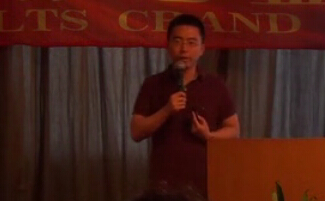雅思阅读真题之Search begins for Earth beyond solar system
2013-08-01 11:28 供稿单位: 新航道
出国英语考试有哪些 雅思6.5是什么水平 雅思阅读评分标准 托福阅读评分标准 雅思和托福的区别
Search begins for 'Earth' beyond solar system
1. A European spacecraft took off today to spearhead the search for another "Earth" among the stars.
2. The Corot space telescope blasted off aboard a Russian Soyuz rocket from the Baikonur cosmodrome in Kazakhstan shortly after 2.20pm.
3. Corot, short for convection rotation and planetary transits, is the first instrument capable of finding small rocky planets beyond the solar system. Any such planet situated in the right orbit stands a good chance of having liquid water on its surface, and quite possibly life, although a leading scientist involved in the project said it was unlikely to find "any little green men".
4. Developed by the French space agency, CNES, and partnered by the European Space Agency (ESA), Austria, Belgium, Germany, Brazil and Spain, Corot will monitor around 120,000 stars with its 27cm telescope from a polar orbit 514 miles above the Earth. Over two and a half years, it will focus on five to six different areas of the sky, measuring the brightness of about 10,000 stars every 512 seconds.
5. "At the present moment we are hoping to find out more about the nature of planets around stars which are potential habitats. We are looking at habitable planets, not inhabited planets. We are not going to find any little green men," Professor Ian Roxburgh, an ESA scientist who has been involved with Corot since its inception, told the BBC Radio 4 Today programme.
6. Prof Roxburgh said it was hoped Corot would find "rocky planets that could develop an atmosphere and, if they are the right distance from their parent star, they could have water".
7. To search for planets, the telescope will look for the dimming of starlight caused when an object passes in front of a star, known as a "transit". Although it will take more sophisticated space telescopes planned in the next 10 years to confirm the presence of an Earth-like planet with oxygen and liquid water, Corot will let scientists know where to point their lenses.
8. Measurements of minute changes in brightness will enable scientists to detect giant Jupiter-like gas planets as well as small rocky ones. It is the rocky planets - that could be no bigger than about twice the size of the Earth - which will cause the most excitement. Scientists expect to find between 10 and 40 of these smaller planets.
9. Corot will also probe into stellar interiors by studying the acoustic waves that ripple across the surface of stars, a technique called "asteroseismology".
10. The nature of the ripples allows astronomers to calculate a star's precise mass, age and chemical composition.
11. "A planet passing in front of a star can be detected by the fall in light from that star. Small oscillations of the star also produce changes in the light emitted, which reveal what the star is made of and how they are structured internally. This data will provide a major boost to our understanding of how stars form and evolve," Prof Roxburgh said.
12. Since the discovery in 1995 of the first "exoplanet" - a planet orbiting a star other than the Sun - more than 200 others have been found by ground-based observatories.
13. Until now the usual method of finding exoplanets has been to detect the "wobble" their gravity imparts on parent stars. But only giant gaseous planets bigger than Jupiter can be found this way, and they are unlikely to harbour life.
14. In the 2010s, ESA plans to launch Darwin, a fleet of four or five interlinked space telescopes that will not only spot small rocky planets, but analyse their atmospheres for signs of biological activity.
15. At around the same time, the US space agency, Nasa, will launch Terrestrial Planet Finder, another space telescope designed to locate Earth-like planets.
(615 words)
副标题#e#
Choose the appropriate letter from A-D for question 1.
1. Corot is an instrument which
(A) can help to search for certain planets
(B) is used to find planets in the orbit
(C) can locate planets with human beings
(D) can spot any planets with water.
Do the following statements agree with the information given in the reading passage? For questions 2-5 write
TRUE if the statement agrees with the information
FALSE if the statement contraicts the information
NOT GIVEN if there is no information on this in the passage
2. Scientists are trying to find out about the planets that can be inhabited.
3. BBC Radio 4 recently focuses on the broadcasting of Corot.
4. Passing objects might cause a fall in light.
5. Corot can tell whether there is another Earth-like planet.
Based on your reading of the passage, complete the sentences below with words taken from the passage. Use NO MORE THAN THREE WORDS for each answer.
With measurements, scientists will be able to search for some gaseous and rocky planets. They will be extremely excited if they can discover some small 6. __________, the expected number of which could be up to 7. __________ .
Corot will enable scientists to study the 8. __________ of stars. In this way, a star’s mass, age and chemical composition can be calculated.
According to Prof Roxburgh, changes in light can be caused by passing planets or star 9. __________. The related statistics can gain us a better 10. __________ of the star formation and evolvement.
Observatories have found many exoplanets, which are 11. __________ other stars than the Sun. The common way used in finding exoplanets can only detect huge gas planets, which do not 12. ___________ .
With the launching of Darwin, astronomers will be able to analyse whether those rocky planets have 13. __________ for life.
副标题#e#
Answer keys:
1. 答案:A (第3段第1句:Corot, short for convection rotation and planetary transits, is the first instrument capable of finding small rocky planets beyond the solar system. A项中的certain planets指small rocky planets beyond the solar system.)
2. 答案:TRUE (第5段第1、2句: At the present moment we are hoping to find out more about the nature of planets around stars which are potential habitats. We are looking at habitable planets, not inhabited planets. 问题中的“that can be inhabited”意思就是inhabitable.)
3. 答案:NOT GIVEN (文中没有提及该信息。)
4. 答案:TRUE (第7段第1句:To search for planets, the telescope will look for the dimming of starlight caused when an object passes in front of a star, known as a "transit".)
5. 答案:FASLE (第7段第2、3句:Although it will take more sophisticated space telescopes planned in the next 10 years to confirm the presence of an Earth-like planet with oxygen and liquid water, Corot will let scientists know where to point their lenses. )
6. 答案:rocky planets (第8段第2句:It is the rocky planets - that could be no bigger than about twice the size of the Earth - which will cause the most excitement.)
7. 答案:40 (第8段第3句:Scientists expect to find between 10 and 40 of these smaller planets.问题中短语“up to”的意思是“达到,高达”,所以应该选择的数字40。)
8. 答案:interiors (第9段第1句: Corot will also probe into stellar interiors by studying the acoustic waves that ripple across the surface of stars, a technique called "asteroseismology". 单词"probe”的词义是“探查,探索”。)
9. 答案:oscillations (第11段第2句:Small oscillations of the star also produce changes in the light emitted, which reveal what the star is made of and how they are structured internally.)
10. 答案:understanding (第11段第3句:This data will provide a major boost to our understanding of how stars form and evolve.)
11. 答案:orbiting (第12段第1句:Since the discovery in 1995 of the first "exoplanet" - a planet orbiting a star other than the Sun - more than 200 others have been found by ground-based observatories.)
12. 答案:harbour life (第13段:Until now the usual method of finding exoplanets has been to detect the "wobble" their gravity imparts on parent stars. But only giant gaseous planets bigger than Jupiter can be found this way, and they are unlikely to harbour life.)
13. 答案:atmospheres (第14段:In the 2010s, ESA plans to launch Darwin, a fleet of four or five interlinked space telescopes that will not only spot small rocky planets, but analyse their atmospheres for signs of biological activity.)
以上就是新航道雅思频道为大家整理的雅思阅读真题之Search begins for Earth beyond solar system,希望对大家有帮助,更多资讯、资料请访问新航雅思真题频道 https://www.xhd.cn/ielts/yucezhenti/

- 新航道,英语成功之道。时间获取新航道英语学习资料和新鲜资讯,请在微信公众账号中搜索「新航道英语」或者「xhdenglish」,或用手机扫描左方二维码,即可获得新航道每日精华内容推送和英语学习经验分享,并参与新航道举办的各项活动。
精彩专题
更多视频荟萃
更多
-
新航道姚骏鹏-雅思阅读高分攻略
时长:03-06

-
新航道陈侃侃-雅思口语要有范儿
时长:03-06

-
【3分钟学雅思】王大锤告诉你为啥药不能停
时长:01-12

-
【3分钟学雅思】全世界个感官餐厅
时长:01-12
热门文章
更多
-
8月31日雅思广州考机考初体验
选择机考模式的考生将通过机考模式参加听...








